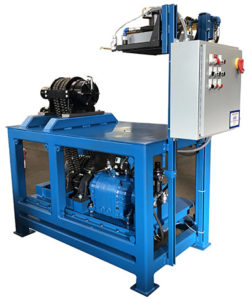Force Control dynamometers featuring Positorq Oil Shear Load Brakes absorb extreme torque at very low speed (down to zero rpm), so that they can accurately capture data at these critical junctures, when dynos equipped with traditional load brakes cannot. Oil shear technology can provide instant load spikes and static lock-up of up to 3-times the continuous load rating.
High cycle counts (up to 300 torque changes per minute) allow tests with a hammering effect on the tested product. Quick, controllable response allows virtually unlimited test capabilities, while their extremely quiet operation allows gearbox, transmission, or final drive noise testing. High-torque, low speed testing is commonly used for testing life cycles, shock loading, overall machine life/performance and more for snowmobiles, forklifts, 2-wheel/4-wheel/6-wheel drive tractors or tracked vehicles, commercial truck axles, helicopter transmissions, gun turrets, winches, hoists, and more.
Proven oil shear technology eliminates wear for service free endurance testing. A variety of sizes and arrangements for shaft mounting, flange mounting, coupled and vertical/horizontal mounting. Units can be supplied with torque arm and load cell, all controls for the cooling system and actuation.
Oil Shear Technology is a system of providing a film of transmission fluid between the friction discs and drive plates of a mechanical multiple disc type of friction brake. As the discs and plates are brought together, squeezing the fluid film, it goes into hydroviscous shear. This phenomenon transmits torque through the fluid through laminar flow.
This phenomenon is based on the laminar flow of the fluid film between the friction discs and drive plates. The fluid tends to flow in layers with each layer moving at consistently different speeds between the rotating friction disc and the static drive plate. As the pressure squeezing the disc and plate together increases the hydroviscous force of the molecules sliding past each other, it increases the torque. Therefore, simply controlling the pressure on the friction stack controls the torque.
The torque is proportional to pressure on the friction stack which is controlled by actuation pressure. This pressure can be provided by a proportional regulator for pneumatically actuated units, or a proportional regulator or servo valve in hydraulically actuated, more responsive systems.
With the fluid layer between the friction disc and drive plate there is no tendency to stick slip or chatter at very low differential speed, providing a smooth transfer of torque down to 0 rpm.
The second part of the equation is heat energy that must be dissipated from the system. Using Oil Shear Technology, the fluid is circulated through the friction stack and is cycled out of the brake to a forced lube cooling system. The cooled fluid cools the brake components including the friction material, eliminating the typical degradation found in dry friction brakes. This also allows for a more compact load brake that can, in many cases, be directly mounted to the axle, or output of the test device. The cooling system typically includes cooling oil pumps, motors, filters, over temperature switches, optional hydraulic actuation pump and motor, flow switches, fluid level sight gauge, optional tank heater, and heat exchangers. Heat exchangers can be oil-to-water or oil to air.
The cooling system can be designed for one load brake or several. Some cooling systems are designed multiple load brakes, such as 4-wheel vehicles using 4 brakes. The hydraulic actuation system can be built into the cooling unit utilizing the same fluid.
The Force Control Industries Positorq load brakes using Oil Shear Technology are available in a variety of sizes ranging from 50 Lb. Ft. (68 Nm) to 300,000 Lb. Ft. (406,700 Nm) and can absorb up to 3000 thermal horsepower (2237 Kw). Mountings vary from flange mount, to foot mounts, to shaft mount. Custom designs and load carrying capacity are commonly developed for specific applications.

